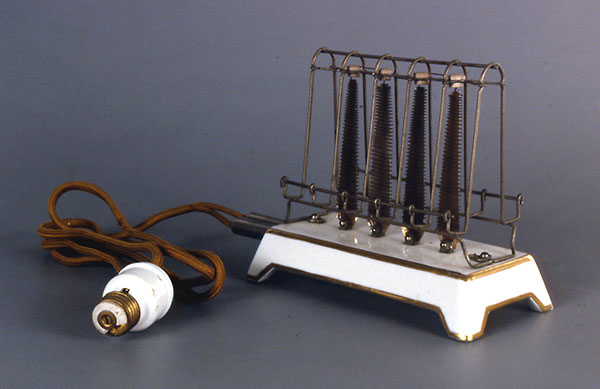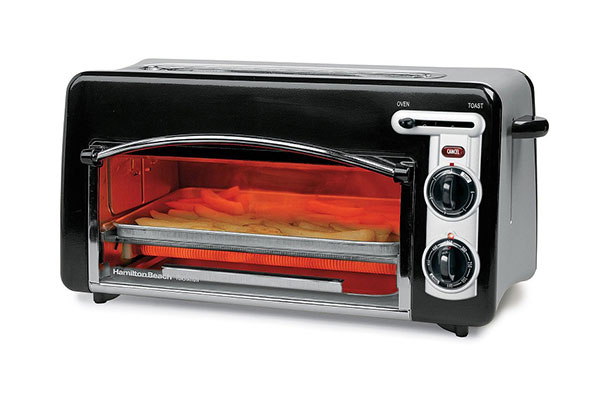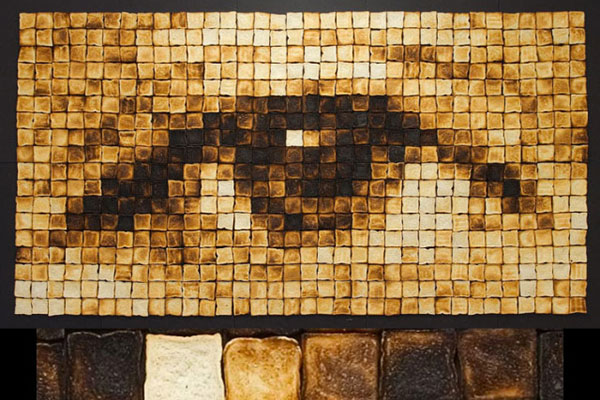An account of how we have toasted bread through the ages, from simple tools used over an open fire to the first automatic toasting devices through to today’s sleek appliances.
The ancient art of toasting bread
Toasting bread is an ancient practice. Early civilizations placed bread over an open fire in order to preserve it, to keep it from growing mold. The bread was toasted on a hot stone in front of the fire. Later on, simple devices were created to toast bread in the fire such as wire frames, to cook the toast more evenly, or sticks like those we use to toast marshmallows over a campfire today. The Romans brought the idea back from Egypt in 500 B.C. The word “toast” actually comes from the Latin “tostum”, which means “to burn or scorch.”
Early toasters
With the arrival of wood and coal stoves in the 1880’s, a new toasting method was needed. This led to a tin and wire pyramid-shaped device. The bread was placed inside and the device was heated on the stove. Fire was the source of heat for toasting bread until 1905 when the engineer Albert Marsh created a nickel and chromium composite, called Nichrome. Marsh’s invention was easily shaped into wires or strips and was low in electrical conductivity. Within months, other inventors were using Nichrome to produce electric toasters.
The first successful version was brought out by Frank Shailor of General Electric in 1909. The D-12 model consisted of a cage-like device with a single heating element. It could only toast one side of the bread at once; the bread had to be flipped by hand to toast both sides. Since the majority of homes had limited access to electrical power, the electric toaster was used only in restaurants. To give an idea of how limited electricity was then, it was generally not even available during daylight hours.

D-12 Toaster, invented in 1909 by Frank Shailor of General Electric, Photo by Eric Norcross
The first Pop-up toaster
With the demand for labor-saving, the number of appliances increased in home use so electric companies began to offer a 24-hour service. Better models soon followed, some with sliding drawers, others with mechanical ways to turn the bread, but the real innovation was the automatic Pop-up toaster, conceived in 1919 by the mechanic Charles Strite. The incorporated timer shut off the heating element and released a pop-up spring when the slice of toast was done.
In 1926, the Waters-Genter Company used a redesigned version of the Strite’s toaster; it was called the “Toastmaster”. With a triple-loop logo inspired by its heating elements, it became part of the modern age of kitchen appliances. By the end of 1926 Charles Strite’s Toastmaster was available to the public; it was a huge success.

Charles Strite’s first mass produced single slot pop-up Toastmaster, toaster for home use, 1926. Photo from Patrick Murfin blogspot
Advertisements promised that it would deliver “perfect toast every time—without watching, without turning, without burning”. This was accurate but only with the first slice of bread; the later bread slices would pop up darker. In 1979 Robert J. Salem from General Electric Company filled in a patent for a temperature sensor in toasters, making everyday toast easier to make.
The arrival of modern toasters
By the 1980’s the development of heat-resistant plastics offered more options for toaster design. Models with rounded sides in a variety of colors became popular. Wider slots for bagels and thick slices of bread also appeared, as well as models with up to six slots for multiple toasting.
By the 21st Century, “smart toasters” has become a frequent marketing term. Using a microchip technology, these toasters are programmed to toast a variety of baked goods from bagels to English muffins to frozen pastries. Dual versions were also introduced. Hamilton Beach introduced a combination toaster/oven/broiler that can toast bread and bake coffee cake. Black & Decker’s Versa-Toast 4-Slice model allows consumers to toast two separate types of bread, such as an English muffin and a slice of raisin bread, at the same time.

Hamilton Beach 22708 Toastation 2-Slice Toaster and Mini Oven
Toaster technology
The toaster continues to be modified according to new technology. Designers create new, versatile looks that fit into any kitchen. Size and capabilities range from simplistic to extreme. The Toaster Automatica, designed by George Watson, is the perfect example of the very latest in toaster design. With two glass plates to heat the bread on either side of the motorized bread slot, and buttons to speed up/down the motor we can make sure we get the perfect toast.
Toast as an icon
The toaster itself has become an icon. Toasters can be found on clothing, on CD covers, and as artwork. The German artist Arne Felix Magold from Tricksal, made the artwork Toast Pixel, exhibit in 2012 in Hamburg. Magold used toasted bread as pixels to create different images, from a kitchen table to an Art Gallery.

Toast Pixels, an artwork made from toast by artist Arne Felix Magold from Tricksal